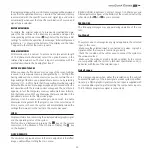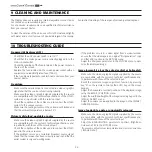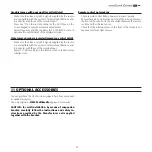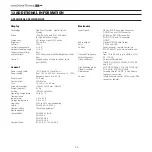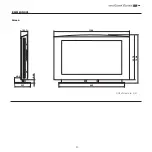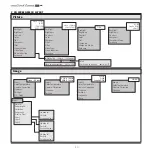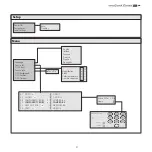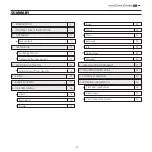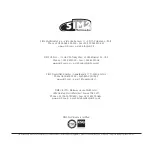
��
21
NORMAL: projects the image occupying the full height of the screen
while maintaining the aspect ratio of the input signal. When the input
signal aspect ratio is 4:3 black vertical bands are displayed on the
right and left of the picture.
Anamorphic: allows a 16:9 picture to be displayed correctly.
LETTERBOX: serves to display a 4:3 letterbox image (with source
signal having black bands above and below the picture) so that it
fills the 16:9 screen and maintains the correct aspect ratio.
PANORAMIC: stretches the 4:3 image, slightly cropping the upper
and lower parts. Panoramic is ideal for displaying a 4:3 image on
the 16:9 screen of the Display.
PIXEL TO PIXEL: displays the image as it is input without adapting
it to the screen.
The image is projected in the centre of the screen and if its hori-
zontal and/or vertical dimensions are smaller than the display, it is
bounded by vertical and/or horizontal black bands.
USER 1, 2, 3: when none of the preset formulas are suitable, the
User formulas are available, with the facility for continuous horizontal
and vertical adjustment of picture size.
COLOR TEMPERATURE
Changes the colour balance of the image and is referred to the col-
our temperature of white. Colours can be adjusted towards the red
end of the spectrum (low colour temperature values - expressed in
degrees Kelvin) or the blue end (high values). Colour temperature
can be selected with three preset values: High, Medium and Low.
In addition, a User setting is provided in which the user can set the
white point by making separate adjustments for Red, Green and
Blue. Generally the High value is more suitable for viewing graphic
images, Medium and Low for video images.
GAMMA CORRECTION
Determines the system’s response to the grey scale, emphasis-
ing or attenuating the different grades of brightness (blacks, dark,
medium, light grey, whites) in the projected image. The GRAPHIC
setting is more suitable for computer images, while the Video and
FILM settings are more suitable for video images.
The Personal setting allows the gamma curve to be defined para-
metrically. The user can select the coefficient that determines the
shape of the curve. Coefficient values between 1.5 and 2.2 serve to
emphasise details in darker parts of the picture although the global
perception of contrast is reduced. Values higher than 2.2 increase
the global perception of contrast while attenuating the visibility of
details in darker areas of the picture. With the most common video
sources a parameter value of 2.2 will give high quality pictures with
the right amount of contrast.
OVERSCAN
Eliminates irregularities around the outer borders of the image.
Certain relatively inaccurate sources can produce an image with
more or less pronounced irregularities around the outer edges;
thanks to the overscan function these imperfections can be moved
to outside the displayed area. Overscan values can be between 0
(no overscanning) and 32 (maximum overscanning). The result-
ing image always maintains the selected aspect irrespective of the
selected overscan value.
POSITION
Use this adjustment to position the image vertically and horizontally.
Determines the aspect of the displayed image.
These parameters do not normally require adjustment because the
system examines the input signal and automatically sets the most
suitable values. However, if the image is not perfectly centralised
it may prove useful to repeat the input signal analysis and the
consequent image positioning procedure. This automatic control
procedure is activated by pressing key “A” on the remote control.
When this procedure is called it is helpful to have a white or light
coloured background on the screen in the current picture.
FREQUENCY/PHASE
These adjustments, available for progressive signals and for signals
from a PC, ensure correspondence between the number of pixels
making up the signal and the number of pixels that make up the
projected image.
These parameters do not normally require adjustment because the
system examines the input signal and automatically sets the most
suitable values. However, if the image appears disturbed (loss of
resolution within equidistant vertical bands or instability and lack of
sharpness on narrow vertical lines) it may help to prompt the system
to repeat the input signal analysis and consequent determination of
the frequency and phase parameters. This automatic control proce-
dure is activated by pressing key “A” on the remote control.
If the automatic procedure fails to have the required effect, enter the
frequency and phase values manually and move sufficiently near to
the screen to observe the effects of the adjustments.



















